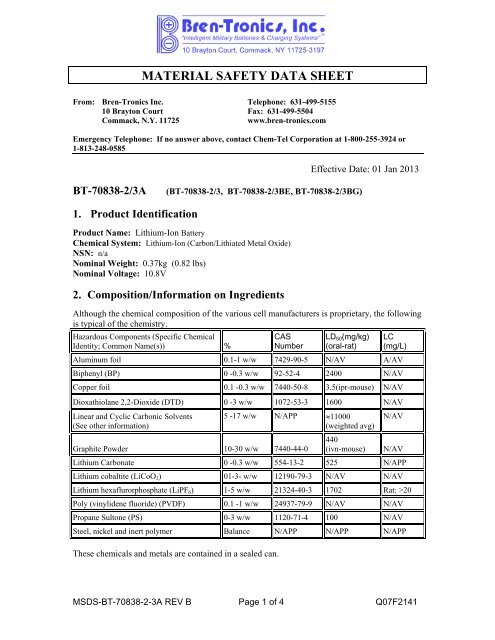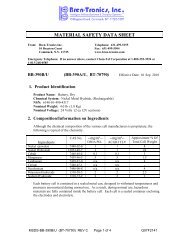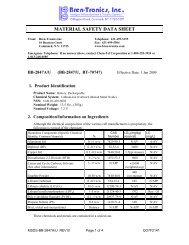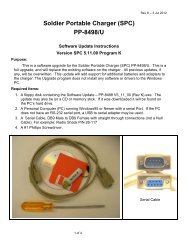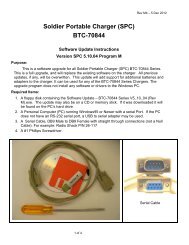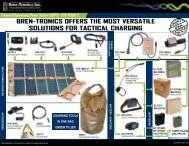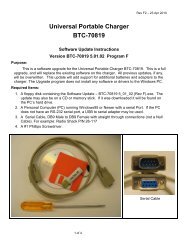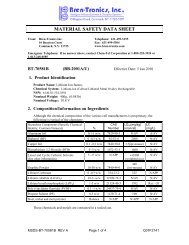MSDS - Bren-Tronics
MSDS - Bren-Tronics
MSDS - Bren-Tronics
You also want an ePaper? Increase the reach of your titles
YUMPU automatically turns print PDFs into web optimized ePapers that Google loves.
MATERIAL SAFETY DATA SHEETFrom: <strong>Bren</strong>-<strong>Tronics</strong> Inc. Telephone: 631-499-515510 Brayton Court Fax: 631-499-5504Commack, N.Y. 11725www.bren-tronics.comEmergency Telephone: If no answer above, contact Chem-Tel Corporation at 1-800-255-3924 or1-813-248-0585Effective Date: 01 Jan 2013BT-70838-2/3A(BT-70838-2/3, BT-70838-2/3BE, BT-70838-2/3BG)1. Product IdentificationProduct Name: Lithium-Ion BatteryChemical System: Lithium-Ion (Carbon/Lithiated Metal Oxide)NSN: n/aNominal Weight: 0.37kg (0.82 lbs)Nominal Voltage: 10.8V2. Composition/Information on IngredientsAlthough the chemical composition of the various cell manufacturers is proprietary, the followingis typical of the chemistry.Hazardous Components (Specific ChemicalIdentity; Common Name(s)) %CASNumberLD 50 (mg/kg)(oral-rat)LC(mg/L)Aluminum foil 0.1-1 w/w 7429-90-5 N/AV A/AVBiphenyl (BP) 0 -0.3 w/w 92-52-4 2400 N/AVCopper foil 0.1 -0.3 w/w 7440-50-8 3.5(ipr-mouse) N/AVDioxathiolane 2,2-Dioxide (DTD) 0 -3 w/w 1072-53-3 1600 N/AVLinear and Cyclic Carbonic Solvents(See other information)5 -17 w/w N/APP ≈11000(weighted avg)Graphite Powder 10-30 w/w 7440-44-0440(ivn-mouse)N/AVN/AVLithium Carbonate 0 -0.3 w/w 554-13-2 525 N/APPLithium cobaltite (LiCoO 2 ) 01-3- w/w 12190-79-3 N/AV N/AVLithium hexaflurorphosphate (LiPF 6 ) 1-5 w/w 21324-40-3 1702 Rat: >20Poly (vinylidene fluoride) (PVDF) 0.1 -1 w/w 24937-79-9 N/AV N/AVPropane Sultone (PS) 0-3 w/w 1120-71-4 100 N/AVSteel, nickel and inert polymer Balance N/APP N/APP N/APPThese chemicals and metals are contained in a sealed can.<strong>MSDS</strong>-BT-70838-2-3A REV B Page 1 of 4 Q07F2141
3. Hazards IdentificationRoutes of Entry:Inhalation? Not anticipated. Respiratory (and eye) irritation may occur if fumes arereleased due to heat or an abundance of leaking batteries.Skin? YesIngestion? YesPotential Health Effects:These chemicals are contained in a sealed can. Risk of exposure occurs only if thebattery is mechanically or electrically abused. The most likely risk is acute exposurewhen a cell vents. Propylene Carbonate is mildly irritating upon eye and skin contact.Contact of electrolyte and extruded lithium with skin and eyes should be avoided.Inhalation or ingestion of lithium trifluoromethane sulfonate may be harmful.Signs/Symptoms of Exposure:Skin and eye irritation may occur following exposure to a leaking battery.Medical Conditions Generally Aggravated by Exposure:An acute exposure will not generally aggravate any medical condition.4. First Aid MeasuresEmergency & First Aid Procedures:If battery is leaking and material contacts eyes, flush with copious amounts of clear,tepid water for thirty (30) minutes, exposed skin for at least fifteen (15) minutes.Contact Physician at once. Leaking contents may be irritating to respiratory passages.Remove to fresh air. Contact physician if irritation persists. If ingested, rinse mouthand surrounding area with clear, tepid water for at least fifteen (15) minutes. Consultphysician immediately for treatment and to rule out involvement of the esophagus andother tissues.5. Fire Fighting MeasuresExtinguishing Media:Water spray, Carbon Dioxide, dry chemical powder or appropriate foam. Use agent appropriate for surroundingmaterialsSpecial Fire Fighting Procedures:In burning, wear self-contained breathing apparatus and protective clothing to prevent contact with skin and eyes.Unusual Fire and Explosion Hazards:Organic components will burn if cell incinerated. Combustion of cell contents will cause evolution of extremelycorrosive Hydrogen Fluoride gas.6. Accidental Release MeasuresVentilation:None under normal use conditions.Protective Gloves:None under normal use conditions. Use butyl gloves when handling leaking batteries.Eye Protection:None under normal use conditions. Wear safety glasses when handling leakingbatteries.<strong>MSDS</strong>-BT-70838-2-3A REV B Page 2 of 4 Q07F2141
7. Handling and StoragePrecautions to be Taken in Handling and Storage:For best service life: store batteries in a cool (below 70° F, 21°C) dry area that is subject to littletemperature changes; do not place near heating equipment, nor exposed to direct sunlight forlong periods. Elevated temperatures can result in reduced battery service life.Other Precautions:Do not diseassemble battery or battery pack. Do not puncture, crush or dispose of in fire.8. Exposure Controls/Personal ProtectionSteps to be Taken in Case Material is Released or Spilled:Notify safety personnel of large spills. Evacuate the area and allow vapors to dissipate.Increase ventilation. Avoid eye or skin contact. DO NOT inhale vapors. Clean uppersonnel should wear appropriate protective gear. Remove spilled liquid with absorbentand contain for disposal.Transport containers outdoors. Hold burned cells and fire cleanup solids for disposal aspotential hazardous waste. Unburned cells are not hazardous waste. A fire with over 100 kg of burned cells willlikely require reporting to environmental offices. Always consult and obey all international, federal and localenvironmental laws.9. Physical and Chemical PropertiesAppearance:Rectangular box shape10. Stability and ReactivityStability:StableConditions to Avoid:Do not heat, crush, disassemble, short-circuit or recharge.Hazardous Decomposition or By-products:Thermal degradation may produce hazardous fumes of manganese and lithium;hydrofluoric acid; oxides of carbon and sulfur and other toxic by-products.Hazardous Polymerization:Will not occur.Incompatible Materials:Contents incompatible with strong oxidizing agents.11. Toxicological InformationCarcinogenicity: NTP? IARC Monograph? OSHA Regulated?No No No12. Ecological InformationN/A13. Disposal Considerations• Batteries must be completely discharged prior to disposal and/or the terminals must be taped or capped to preventshort circuit.• Disposal of large quantities of batteries containing lithium cells may be subject to Federal, State or localregulations.<strong>MSDS</strong>-BT-70838-2-3A REV B Page 3 of 4 Q07F2141
14. Transportation Information: This lithium-ion battery is regulated as a Class 9 Misc hazardous material (dangerousgoods). The UN number for the US is UN 3090; International is UN 3480. Equivalent Lithium Content, (ELC), per batteryis 6.12g max. The Watt-hour rating is 73 Wh max. The battery and component cells conform to the requirements of Section38.3 of the UN Manual of Tests and Criteria, (T1-T8 tests). The battery must be packaged and shipped according to thefollowing regulations starting on January 1, 2013):Domestic Transportation within the U.S. - All Modes: See 49 CFR Section 173.185; Special Provision 188:Battery is “excepted” from Class 9 Hazardous Materials Regulations because it contains less than 8g ELC.Battery must be packaged in a manner TO PREVENT SHORT CIRCUITS and in a strong outer package.For quantities of 13 or more in one package, 1) mark “LITHIUM-ION BATTERIES INSIDE" on the package and thatspecial procedures should be followed if package is damaged; (or IATA label shown below); 2) Accompany with adocument indicating same information; 3) Package must be capable of being dropped 1.2 meters in any orientation withoutdamage to cells or batteries contained in the package, without shifting of the contents that would allow short circuiting, andwithout release of package contents; 4) The maximum gross weight of the package may not exceed 30 kg (66lbs). Note:these requirements will reflect Int’l regs below later in 2013. However, some U.S. carriers may require compliance now.International Transportation – All Modes: IMDG Code, ADR, ICAO Technical Instructions, IATADangerous Goods Regulations:IMDG Code and ADR, Special Provision 188: Battery is “excepted” from Class 9 Dangerous Goods Regulationsbecause it has a rating of less than 100 Wh. Battery must be packaged in a manner TO PREVENT SHORT CIRCUITS.Battery must be packed in inner packagings that completely enclose the battery, then placed in a strong outer packagecapable of withstanding a 1.2m drop test in any orientation without damage to the batteries, shifting of contents to allowbattery to battery contact or release of contents. Package must carry label similar to the IATA lithium battery handlinglabel shown below. Package must be accompanied with a document such as an air waybill with an indication that: thepackage contains lithium-ion batteries, must be handled with care, that a flammability hazard exists if the package isdamaged, special procedures should be followed in the event the package is damaged, to include inspection and repacking ifnecessary, and a telephone number for additional information. Package may not exceed 30 kg (66 lbs) gross weight.IATA Dangerous Goods Regulations / ICAO Technical Instructions: Packing Instruction 965, Section II.No more than 2 batteries per package. Packaging and documentation requirements are same as shown above for IMDGand ADR. IATA and ICAO specifically require lithium ion battery handling label shown below. No package weight limit.IATA Dangerous Goods Regulations / ICAO Technical Instructions: Packing Instruction 965, Section IB.More than 2 batteries per package. Packaging and documentation requirements are same as shown above for IMDG Codeand ADR and package must carry Class 9 label and lithium battery handling label shown below. In addition, shipmentmust be offered to airline as fully-regulated Class 9 dangerous goods, accompanied with shipper’s declaration for dangerousgoods (or alternative document with similar entries) and employees must have dangerous goods training. Package may notexceed 10 kg (22 lbs) gross weight.15. Regulatory InformationBatteries are considered to be “articles” and thus are exempt from TSCA regulation.16. Other InformationAvoid mechanical or electrical abuse. DO NOT short circuit or install incorrectly. Batteries may explode, pyrolize or ventif disassembled, crushed, recharged incorrectly or exposed to high temperatures. Install batteries in accordance withequipment instructions.This information and recommendations set forth are made in good faith and believed to be accurate as of the date of preparation. <strong>Bren</strong>‐<strong>Tronics</strong> Inc.makes no warranty, expressed or implied, regarding the accuracy of the data or the results to be obtained from the use thereof.<strong>MSDS</strong>-BT-70838-2-3A REV B Page 4 of 4 Q07F2141


